| THE INDUSTRIAL RAILWAY RECORD |
© FEBRUARY 1973 |
![]()
SCHWARTZKOPFF LOCOMOTIVES
In the March 1971 issue of "Railway Scene" there is a brief description of several industrial railways in Paraguay which had been visited in July 1970. The author, Jeremy Wiseman, had found "a curious articulated locomotive mounted on two four-wheel bogies with inside cylinders" stored out of use on the 760mm gauge system based on Puerto Casado. Builder's details are given as Schwartzkopff 8459 of 1925. This would seem to be an extant example of the locomotives referred to in letters in Volume 3 of the RECORD (pages 54, 128 and 223) and page 112 of RECORD 38.
| BLURTON, STOKE-ON-TRENT |
J. K. WILLIAMS |
PICTURE PARADE
The late R.H. Inness suggested that the Dick Kerr locomotive CADBURY (see illustration on page 167 of RECORD 28) was built by Kerr Stuart as the prototype of their 'Moss Bay' class. Whilst there is indeed a quite definite family likeness, the plate date (1904) on CADBURY does not suggest that it was the prototype of the 'Moss Bay' design of which the first recorded example, Kerr Stuart 683, was supplied in 1900 to the Moss Bay Hematite Iron & Steel Co Ltd, Cumberland. This sturdy locomotive had 15in by 20in cylinders and 3ft 3in wheels. Between 1900 and 1930 another 48 were built for various customers, this total including the Kerr Stuart yard locomotive, works number 4226. In addition to these, Kerr Stuart built (for an Indian customer) a solitary 2‑4‑0 crane tank (4222 of 1922) which was based on the 'Moss Bay' design. An unusual feature of this locomotive was the :act that all the wheels were 3ft 3in diameter! Slight variations from the basic design occur: Kerr Stuart 729 (built 1900 for Brunner, Mond & Co Ltd, Northwich) had 14in cylinders, and of the last twelve 'locomotives of the class, the first eleven had 3ft 6in diameter wheels. Bagnall also turned out an 0‑4‑0 saddle tank named MOSS BAY which was very similar to the Kerr Stuart design. I understand that this locomotive went to India in 1935.
There was a nineteenth century business association between Dick Kerr and Kerr Stuart, and it is interesting to note that the first entry (works construction number 51) in the latter's Engine Register relates to a locomotive built by Hartley, Arnoux & Fanning for Dick Kerr, and supplied by Kerr Stuart to an unknown purchaser in the West Indies!! Details of locomotives supplied by Kerr Stuart before they commenced building about April 1893 (following their acquisition of Hartley, Arnoux & Fanning in March or April of the same year) are not fully recorded in their Engine Register. 'Works' numbers start at 51 (in 1891) and there is no break until they jump from 120 to 621. This occurs in 1897. Some, but riot all of the locomotives in the 51 to 120 batch carried plates bearing other Kerr Stuart 'works' numbers in the 5xx series. For example, Hartley, Arnoux & Fanning 55 and 56 are believed to have carried Kerr Stuart numbers 556 and 557. No complete list of the 5xx series survives and such entries as there are (between 520 and 577) appear to have been written up much later than the date of construction or supply.
There is every reason to suppose that from 'works' number 77 at least, the Kerr Stuart Engine Register includes all locomotives constructed by themselves, and as there is no reference to any locomotive named CADBURY it seems doubtful whether they built it. Kerr Stuart's 'Moss Bay' type may have been based on a Dick Kerr design, although CADBURY's cylinders seem smaller than 15in - at a guess possibly 10in or 12in. Notice also the difference in chimney height between CADBURY and the 'Moss Bay' design.
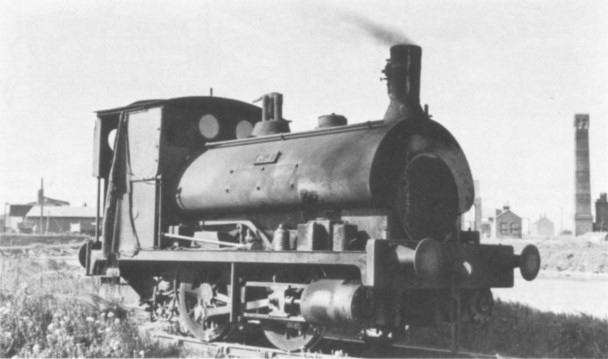
The Dick Kerr locomotive at Queenborough Wharf, 1950. Note the closeness of the cab spectacles - evidence that the locomotive was originally fitted with just a weatherboard, the overall cab being added at a later date. (F. Jones)
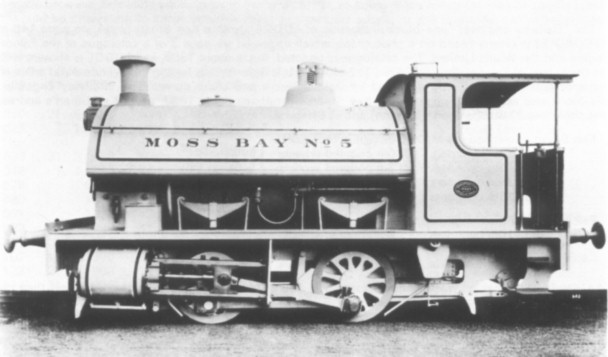
Official photograph of the first 'Moss Bay' locomotive, Kerr Stuart 683 of 1900.
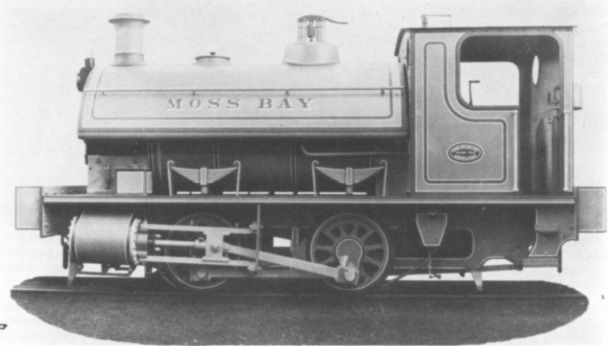
Official photograph of a later 'Moss Bay' locomotive, Kerr Stuart 4007. This was fitted with dumb buffers instead of the more conventional spring type, and supplied in 1919 to the Barrow Hematite Steel Co Ltd.
Frank Jones has kindly provided a photograph of a similar Dick Kerr locomotive (reproduced herewith) which was taken in 1950 at Settle, Speakman & Co Ltd, Queenborough Wharf, Kent. Its previous history is a little obscure: then No.3, it was formerly named MAYBURY. The photograph shows six bolt holes or pads on the saddle tank where a large nameplate had been attached. A large nameplate as on CADBURY? Is it possible that MAYBURY was also originally at Cadbury Bros? And if so, what is the significance of its name?
|
MÉCANICIEN II |
THE BRITISH NORTH BORNEO STATE RAILWAY
I can add a little to the late A. N. M. Garry's most interesting article on page 227 of RECORD 30, having recently received some photographs taken there by a friend in December 1971. The line is now the Sabah State Railway and the Vulcan 2‑6‑2's are Class 6, one photograph showing two of them, the nearer carrying a cast plate on the boiler front reading 6‑016. There are also cast number plates on the cab sides. 7, the Hunslet 4‑6‑4 tank illustrated on page 241, still carries this number but on the tank sides, the bunker now displaying the State's coat of arms. Three modern diesels are also visible, but they do not appear to have received the continental style renumbering of the Vulcans as one is plainly carrying the number 30.
| BROMLEY, KENT |
R. T. HORNE |
(Penney 1009, illustrated on page 229, shows a marked resemblance to MIDGE (RECORD 39, page 148). The letter from Mr Higgins elsewhere in this issue shows MIDGE to be a Falcon product and substantiates further the suggestion that Penney were agents for Falcon and Brush. — TJL)
MIDGE
The "Railway Engineer" line-block illustration of MIDGE (with a Kerr Stuart plate) on page 148 of RECORD 39 is clearly based on a photograph which appeared on page 2 of a catalogue of the Falcon Engine and Car Works Limited. The catalogue is undated, but is about 1889, and MIDGE is shown, with the usual type of Falcon plate, as Falcon 132 of 1887. It is described as having 7in cylinders and a Bissell bogie or radiating axle, being designed for light railways and sharp curves. The "Railway Engineer" line-block also appears on page 116 of Kerr Stuart's catalogue dated 1892, when Kerr Stuart's address was shown as 20 Bucklersbury [London] and at Glasgow.
Kerr Stuart advertised the MIDGE design in four sizes:
| 7in x 12in cylinders | 2ft 0in coupled wheels | £590 |
| 8in x 12in cylinders | 2ft 3in coupled wheels | £640 |
| 9in x 15in cylinders | 2ft 6in coupled wheels | £695 |
| 10in x 15in cylinders | 2ft 9in coupled wheels | £740 |
Falcon offered their engine in three sizes, but quoted no prices:
| 6in x 10in cylinders | 1ft 9in coupled wheels |
| 7in x 12in cylinders | 2ft 0in coupled wheels |
| 8in x 12in cylinders | 2ft 3in coupled wheels |
The weight of the Falcon was given as 7 tons (net) and 8½ tons (gross), in each case ton less than the Kerr Stuart figures.
The 1892 Kerr Stuart catalogue was evidently intended as a comprehensive guide to the wide range of railway and tramway equipment which the firm were ready to supply. Falcon and one or more of the Kilmarnock firms were evidently the main sources of their locomotive supply. I think it was the late R. H. Inness who told me that for several years Kerr Stuart & Co and Dick Kerr & Co acted only as agents for the supply of equipment but, apparently as the result of a dispute or of contract regulations, the two firms acquired their own workshops to comply with the requirements of the Crown Agents or other authorities.
| WORCESTER |
S. H. P. HIGGINS |
SHROPSHIRE & MONTGOMERYSHIRE RAILWAY
The inside cylinder 0‑6‑0 saddle tank illustrated on page 155 of RECORD 40 appears to be an early Hunslet, having several features of this maker as follows: a deeper saddle tank than contemporary Manning Wardles; a fatter safety valve bonnet with a pronounced lip; a flare to the rear bunker which starts well above the line of the front bunker whereas with Manning Wardles these were almost in line. Lastly, and convincingly, the rear handrail to the footplate is a typical Hunslet feature. Manning Wardles always had theirs the same length as the front rail and mounted in line with it.
| LOUGHTON, ESSEX |
FRANK JONES |
(Eric Tonks was recently informed that the contract for the reconstruction of the line was awarded to Francis C. Mathews, the tender being for £30,000. Does this enable any of our more knowledgeable readers to identify the Hunslet?— TJL)
THE ORIGINS OF ORENSTEIN & KOPPEL
With reference to the mention of Arthur Koppel in this article (RECORD 40, page 156), I was interested to come across several mentions of his name in a list of locomotives constructed by The Dickson Manufacturing Company of Scranton, Pennsylvania, one of the constituents of the American Locomotive Company. This list formed an appendix to a reprint of an 1885 catalogue of the firm's products. The following list is compiled from this appendix, details of the purchaser and the locomotive number/name being exactly as they appear in the list. The date given is presumably that of despatch. No differentiation is made between side and saddle tanks in the original list, so some of the following may be saddle tanks. It would be interesting to know whether these locomotives appear in any South African or Indonesian lists and whether they are credited to Koppel or Dickson.
|
Shop Number |
Date |
Gauge | Type | Number/Name | Notes | Purchaser |
| 989 | 31. 3.1898 | 60cm | 0-4-0T | (a) |
A. Koppel for Portuguese East Africa |
|
| 990 | 21. 5.1898 | 60cm | 0-4-0T | DE GHEIST | (a) | A. Koppel for South Africa |
| 1023 | 7. 1.1899 | 28in | 0-4-0T | (b) |
A. Koppel (destination unknown) |
|
| 1039 | 31. 3.1899 | 60cm | 0-4-0T | JAVA | (c) | A. Koppel (For Java) |
| 1042 | 1. 4.1899 | 24in | 0-4-2T | 7 GEMOE | (d) | A. Koppel (For Java) |
| 1079 | 1899 | 42in | 2-6-0T | 1 J. S. SMIT | (e) |
Cape Collieries Ltd, South Africa, via Koppel |
| 1080 | 1899 | 42in | 2-6-0T | 2 J. J. SPIER | (e) | |
| 1081 | 1899 | 42in | 2-6-0T | 3 L. J. MEYER | (e) | |
| 1082 | 1899 | 42in | 2-6-0T | 4 C. BIRKENSTOCK | (e) | |
| 1091* | 18. 8.1899 | 24in | 0-4-0T | PORFIRIO DIAZ | (b) | A. Koppel, for Mexico |
| 1107 | 10. 2.1900 | 285/16in | 0-4-0T | (d) |
Rand Mines, South Africa, via A. Koppel |
|
| 1123 | 21. 3.1900 | 27½in | 0-4-2T | (d) | ||
| 1124 | 21. 3.1900 | 27½in | 0-4-2T | (d) | ||
| 1174 | 25. 9.1900 | 27½in | 0-4-2T | 1 | (d) | A. Koppel, for Tersana |
| 1175 | 25. 9.1900 | 27½in | 0-4-2T | 2 | (d) | A. Koppel, for Tersana |
| 1205 | 16. 2.1900 | 36in | 0-4-2T | I oei Tjone Nio | (b) | A. Koppel for Java |
| 1206 | 16. 2.1900 | 27½in | 0-4-2T | II Redjo Agoong | (b) | |
| 1207 | 28. 2.1900 | 27½in | 0-4-2T | III oei Hwie Nio | (b) | |
| 1219 | 29. 3.1900 | 235/8in | 0-4-2T | 2 GEMOE | (d) | |
| 1220 | 29. 3.1900 | 27½in | 0-4-2T | BODJONG | (d) | |
| 1240 | 29. 3.1900 | 27½in | 0-4-2T | SENPUHVADAK | (d) | A. Koppel** |
| 1285 | 7.12.1901 | Metre | 4-6-0 | 23 SAN SALVADORE | (f) | A. Koppel, for Spain |
| 1286 | 7.12.1901 | Metre | 4-6-0 | 24 BONOZA | (f) | A. Koppel, for Spain |
| 1288 | 27. 5.1901 | 235/8in | 0-4-2T | (d) | As 1107 |
* Locomotive
actually built by Vulcan Iron Works, construction number 229.
** No destination is given: presumably Java.
Notes
(a) Cylinders
6in x
9in: Wheel diameter 22in.
(b) Cylinders
8in x 12in: Wheel diameter 28in.
(c) Cylinders
6in x 10in: Wheel diameter 22in.
(d) Cylinders
6in x 10in: Wheel diameter 24in.
(e) Cylinders 14in
x 20in: Wheel diameter 44in.
(f) Cylinders 14in
x 20in: Wheel diameter 38in.
| LIVERPOOL |
JIM PEDEN |
(F. Kemper comments: 'The locomotives delivered to Java will not appear in any Indonesian Railways lists as all of them were plantation locomotives. Of the South African locomotives, I only know that one of them, Dickson 1288, went from a mining concern to become South African Railways number NG93. The 4‑6‑0's listed for Spain were in fact also tank engines although the list does not make this clear: they were the old 23 and 24 of the FC de Santander a Bilbao and Society records show them as Dickson 1285 and 1286 respectively.'
Several of the locomotives for South Africa are mentioned in "Industrial Locomotives of Southern Africa" by Union Publications. Cape Collieries Ltd of Bamboo Junction, Cape Province, is shown as receiving Dickson 1079‑82 new: they were outside cylindered 2‑6‑0 saddle tanks with names and numbers corresponding with the original Dickson catalogue appendix. They became Cape Government Railways 50‑53 in 1900 when the colliery line was taken over, and presumably all passed to South African Railways as two of them were later sold by the SAR to the Pretoria Cement Co Ltd. Dickson 0‑4‑2 saddle tanks 1107, 1124, 1288 (and also 1102 of 1889, not listed in the original appendix) are shown as being delivered new to the Rand Mines Group in the Transvaal, but individual allocations are not given. Two were later owned by South African Railways, becoming their NG93 and NG94. It is interesting to note that the Rand Mines Group also owned three outside cylindered 0‑4‑0 side tanks by Orenstein & Koppel. The Zebediela Estates of Transvaal had a Dickson 0‑4‑2 tender/tank locomotive with outside cylinders which came from SAR (NG93), so is presumably Dickson 1288. Dickson also supplied two 0‑4‑2 saddle tanks with outside cylinders to the Lancaster Gold Mining Co at Roodeport in the Transvaal. It is not known if these 2ft gauge locomotives, Dickson 978 of 1897 and 1019 of 1898, were also to the order of A. Koppel. Possibly the two derelict American locomotives mentioned by Frank Jones on page 275 of RECORD 44 are amongst those listed by Jim Peden. — TJL. )
Understandably, few Continental built locomotives ever worked in Great Britain. Of those that did, the majority were products of Orenstein & Koppel and the appearance of this article in RECORD 40 (page 156) prompted me to forward the photographs reproduced here. Both were employed on reservoir construction work in Derbyshire — KINDER at Fernilee, near Buxton, and SYDNEY at Ambergate.
| BEDWORTH, NUNEATON |
RAY FOX |
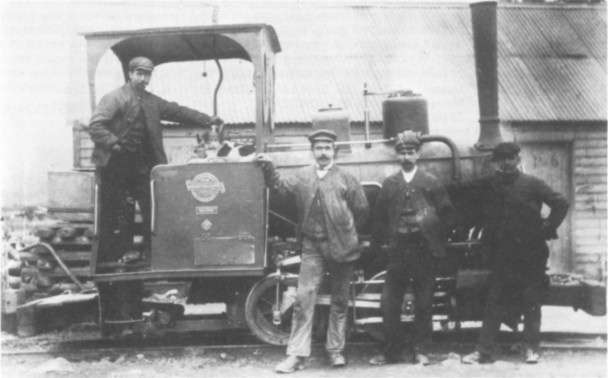
Orson Wright & Co made use of SYDNEY between 1907 and 1911 during the construction of Ambergate Reservoir. The locomotive - an 0‑4‑0 well tank - is thought to be Orenstein & Koppel 1480, but confirmation of the works number is required. The locomotive passed to H. Arnold & Son on 10th May 1912, and is almost identical to that depicted in the 1902 advertisement on page 369 of RECORD 34.
(collection of Frank D. Smith)
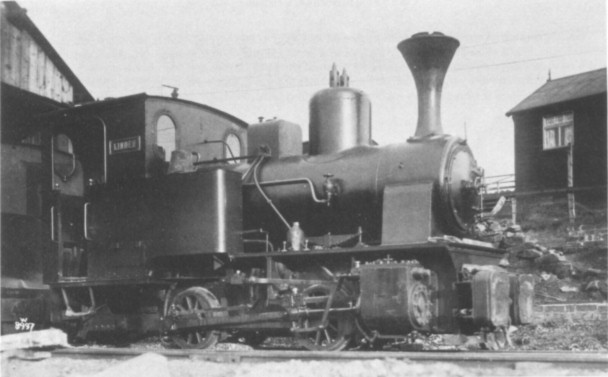
Considerably larger than SYDNEY was KINDER, a 3ft 0in gauge Orenstein & Koppel (10903 of 1925). It was employed by Lehane McKenzie & Shand Ltd on the Fernilee Reservoir contract.
(Real Photographs Co Ltd, W 8997)
EARLY PETROL LOCOMOTIVES
The Works mentioned and illustrated on page 174 of RECORD 40 is almost certainly the former Siemens Cable Works off Westfield Street, Woolwich, latterly within the GEC combine, and closed during this Company's recent reorganisation. This comprised several buildings grouped around a large yard, which seems to agree with the background shown in the picture. Most of the works along the banks of the Thames have had tramways and it is logical to expect that some may have employed locomotives.
| BIRCHENCLIFFE, HUDDERSFIELD |
M. SWIFT |
(The Rampgill Mine
– see page 22 of RECORD 35 – had yet another type of "New Century" locomotive. The February 1913 issue of the "Locomotive Magazine" reported that a 12‑14hp "New Century" locomotive had been at work there for nearly a year with such success that a second machine of the same make had just been delivered. Two gears giving speeds of 2½ and 5mph were provided, the drive being transmitted to all four wheels through gears and chains. One of the four redundant pony drivers had charge of the locomotive which was working trains of 35‑40 tons. Five to six gallons of petrol were used daily in removing over 200 tons of ore from the mine which was situated on the hillside above the 1,600ft contour. The locomotive worked in an adit 3ft 4in wide and about 5ft 3in high which extended some 3,000 yards into the hillside. — KPP)
HUNSLET 3902
I was interested in the article which appeared in RECORD 41 (page 177) and, in particular, the photo of the worksplate showing the engine's cylinder dimensions. This has been Hunslet practice for some years now, and something similar has been done in the case of diesel locomotives, these carrying plates displaying horse-power rating. One wonders what purpose is achieved by this practice. I don't think it was ever done by any other British locomotive building firms. Perhaps someone can offer an explanation.
| DAWLISH, DEVON |
R. A. WHEELER |
PICTURE PARADE
It may interest readers to know that Hawthorn Leslie 3900 of 1937 (illustrated on page 192 of RECORD 41) was supplied to Phoenix Colliery in 1937 and worked there until sold to Ballengeich about 1970. The second photograph depicts North British 27247 of 1952, not 26247 of 1948. 27247 was built for Daggafontein Mines Ltd and when their gold mines closed in 1967 it went to South African Coal Estates (Landau), where it was stored before being loaned to their Navigation section at Clewer to replace a scrapped SAR class H2 tank. 26247 is Vereeniging Estates Ltd No. 3, there being clearly recognizable differences between this and 27247. The query on the third photograph is easily answered as No.5 is one of the numerous Class H2 tank locos of the SAR now to be seen in private service. These were built by Dubs and North British between 1899 and 1903 as the famous Reid ten wheeler of the Natal Government Railways, and were rebuilt from 4‑10‑2 tanks to 4‑8‑2 tanks in 1911 and 1912. Hlobane Colliery had one (not two) Baldwin 2‑10‑2 tank (61553 of 1930); this has not been scrapped but rebuilt and was working in August 1972. (Enyati Colliery, which is some miles from Hlobane, had two Baldwin 2‑10‑2 tanks of which one has been scrapped and one rebuilt as a 2‑10‑0 tender-tank engine.)
| WADEVILLE, SOUTH AFRICA |
P. J. LUCAS |
A FOX WALKER MYSTERY
In the editorial footnote to this article on page 196 of RECORD 41, you mention that Fox Walker 219-226 were works numbers for "tenders", but surely this should be "locomotives and tenders". I don't think it was Fox Walker practice to allot separate works numbers for tenders.
| DAWLISH, DEVON |
R. A. WHEELER |
(It seems that the confusion created by Peckett in this matter has been came don by us! The information in the penultimate paragraph of the editorial footnote was compressed to save space, and this appears to have caused its misinterpretation. If we may recapitulate, the even numbered orders of the 382-389 batch covered locomotives with works numbers 217-226; the odd numbered orders covered their tenders for which works numbers were NOT allotted. Similarly the odd numbered orders of the 391-398 batch covered locomotives 227-241, and the even ones the tenders for them. — KPP)
I was interested in the notes of the Argentine 0‑4‑2 which appeared in RECORD 41. For a period it was exhibited at Lujan, and is now on display at the entrance to Cordoba Works, on the metre gauge Belgrano line. Incidentally, BELGRANO on the locomotive photo on page 194 is the name of the railway, not of the engine. As preserved the locomotive is numbered 1, and the notice board states that it hauled the first train between Cordoba and Tucuman on 30th October 1876. The elaborate Fox, Walker plate on the cabside, presumably the original, shows the date as 1842. When was Fox, Walker & Co founded ?
| HORLEY, SURREY |
D. TREVOR ROWE |
CORNISH BAL LOCOMOTIVES
The name of the Koppel locomotive at the Basset Mines (RECORD 41, page 197) was KIMBERLEY, as mentioned in my letter on page 53 of RECORD 36. Mr Trounson told me many years ago that she was named after William James, manager of the Basset Mines. This gentleman was familiarly known as 'Kimberley" James on account of his earlier prominent association with the Kimberley diamond mines in South Africa.
| BLURTON, STOKE-ON-TRENT |
J. K. WILLIAMS |
RAILWAYS IN ICELAND
With reference to this article (RECORD 42, page 216), Arn Jung built only two 0‑4‑0 tanks for 900mm gauge in 1892. These were supplied to R. Dolberg of Rostock (an agent) and their works numbers were 129 and 130. In view of its name, one might presume that PIONER was 129 and MINOR 130.
| TUNBRIDGE WELLS |
W. H. G. BOOT |
(An unfortunate error crept into this article: at the bottom of page 217; 60km should read 6km. — TJL)
NARROW GAUGE BALDWINS IN INDIA
The Baldwin Locomotive Works built 506 60cm gauge 4‑6‑0 side tanks of Class 10‑12‑D in 1916-1917, of which all but the first eleven were delivered to the British War Department (ROD). The 10‑12‑D serial numbers 12 to 506 were stamped in works number order on motion parts. According to Baldwin's official records, which I was able to inspect at their Eddystone Works, WD Nos. 701-715 were ordered as 546-560.
|
WD(ROD) |
Baldwin |
Date |
|
|
|
| 501- 505 | 44335-44339 | 10/1916 | 790- 889 | 44695-44794 | 1/1917 |
| 506- 545 | 44351-44390 | 10/1916 | 890- 900 | 44891-44901 | 1/1917 |
| 701- 706 | 44489-44494 | 11/1916 | 901-1000 | 44938-45037 | 1/1917 |
| 707- 756 | 44507-44556 | 12/1916 | 1001-1104 | 45133-45236 | 2/1917 |
| 757- 781 | 44635-44659 | 12/1916 | 1105-1114 | 45374-45383 | 3/1917 |
| 782- 789 | 44681-44688 | 12/1916 | 1115-1150 | 45398-45433 | 4/1917 |
Several of these locomotives later went to India, and the record books contained manuscript entries of the operators from whom letters requesting spare parts had been received, as under:-
Begg (or Bogg) Sutherland (no date):
44791 and 45144.
Bengal Coke & Coal Products Ltd (by 7/1929): 44728.
India Office (by 11 /1920): 44361, 45007 and 45200.
Jagadhri Light Railway (by 3/1935): 44528 and 44708.
Japaha Sugar Factory (no date): 44769 and 44774.
Makerwal Colliery (by 1/1934): 44519, 44551, 44753 and 45036.
Robert Hudson (India) (no date): 44641, 44750, 44894, 44948, 44974, 44998 and
45190.
Robert Hudson (India) - Davrala Light Railway (by 1/1935): 44656 and 44972.
Tata Ltd (by 11 /1920): 44552, 44636, 44657 and 44696.
Three of the 280 Baldwin-built 60cm gauge Pêchot 0‑4‑4‑0 side tanks for the French Government Artillery Railways also found their way to India after World War 1. Baldwin 44137 of 9/1916 and 44449 of 11/1916 (FGAR 293 and 342) were at the Makerwal Colliery by January 1934. Spares were ordered for Baldwin 44258 of 10/1916 (FGAR 313) by the Algerian State Railways in August 1921, but by March 1935 it had arrived on the Jagadhri Light Railway in India. Because of the Bolshevik revolution in 1917 certain locomotives were not delivered to Russia. Baldwin 50678, a 2ft 5.53in gauge 0‑6‑0 tank intended for the International Engineering & Trading Company, was diverted to the British War Department, India, and shipped in November 1918 to the 2ft 6in gauge Kulna-Bagheret Railway (operated by the Eastern Bengal Railway). Two 2ft 5.53in gauge 0‑6‑0 tender locomotives (Baldwin 50788 and 50789) intended for the Alapeff Mining Company in Russia were rebuilt by Baldwin to 0‑6‑0 tanks and then despatched in December 1918 to the War Department in India, being assigned respectively to the Dehri-Rhotas Railway and the Bengal Provincial Railway.
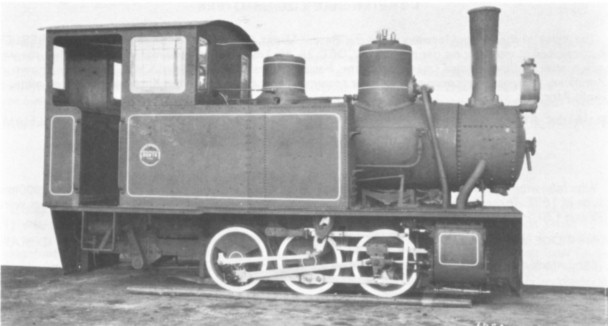
Baldwin 50678 of December 1918 (per the worksplate) became 9 on the 'Kulna-Bagheret' Railway. It had 10in by 14in cylinders and 2ft 4in wheels. (courtesy H. L. Broadbelt)
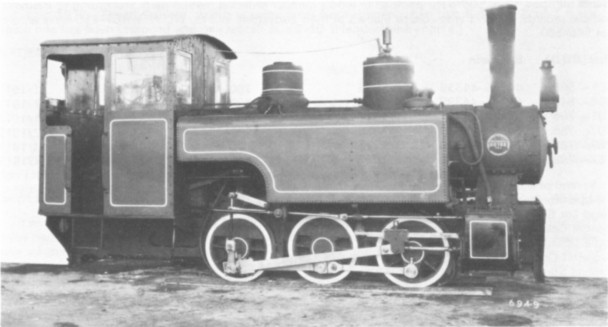
Baldwin 50788 of December 1918 had 11in by 16in cylinders and 2ft 7½in wheels and was assigned to the Dehri-Rohtas Railway by the War Department. Note that on both these official photographs the tracks on which the locomotives stand are no more than lengths of timber! (courtesy H. L Broadbelt)
I shall be pleased to hear of any First World War narrow gauge Baldwins located by readers in India, whether in confirmation of my own notes or complementary to them.
| NEW YORK, USA |
H. L. GOLDSMITH |
(There appear to be a few minor discrepancies in the official Baldwin records concerning these locomotives and their destinations. Baldwin 50678 is stated as being shipped in November 1918 but the worksplate shows the building date as December 1918. The "Kulna-Bagheret Railway" is probably that between Khulna and Bagerhat, both places being in East Pakistan. The Dehri-Rohtas Light Railway is mentioned on pages 25 and 26 of "Indian Narrow Gauge Railways" by Hugh Hughes and Frank Jux but there is no mention of Baldwin 50788 so possibly its stay on that particular system was short.
– TJL)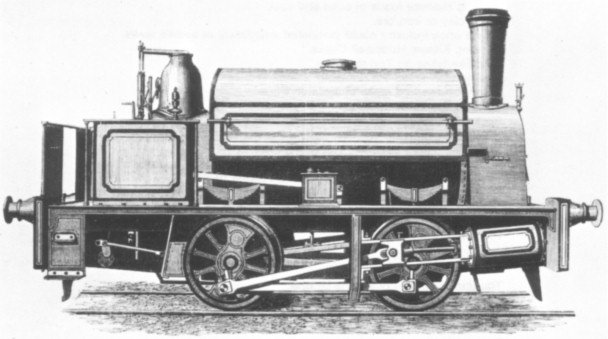
COLLIERY LOCOMOTIVE. This engine was 'constructed by Messrs. Head, Wrightson, and Co., Engineers, Stockton-on-Tees. It is built to designs some time since prepared by Messrs. Head, Wrightson, and Co., for what may be termed standard colliery engines. The general features will be gathered at a glance. The dimensions are varied to suit different purchasers, the cylinder diameter ranging from about 8in. to 11in., the dimensions of the boilers being of course increased in proportion. These locomotives are strong and well made, and the moving parts are all accessible. The type is, on the whole, a very good one, and the engine simple and workmanlike.'
("The Engineer'; 15th December 1871. Are readers able to identify this particular machine - which seems to possess several characteristics of contemporary Black Hawthorn locomotives - or provide any information concerning Head Wrightson locomotives ? — TJL)